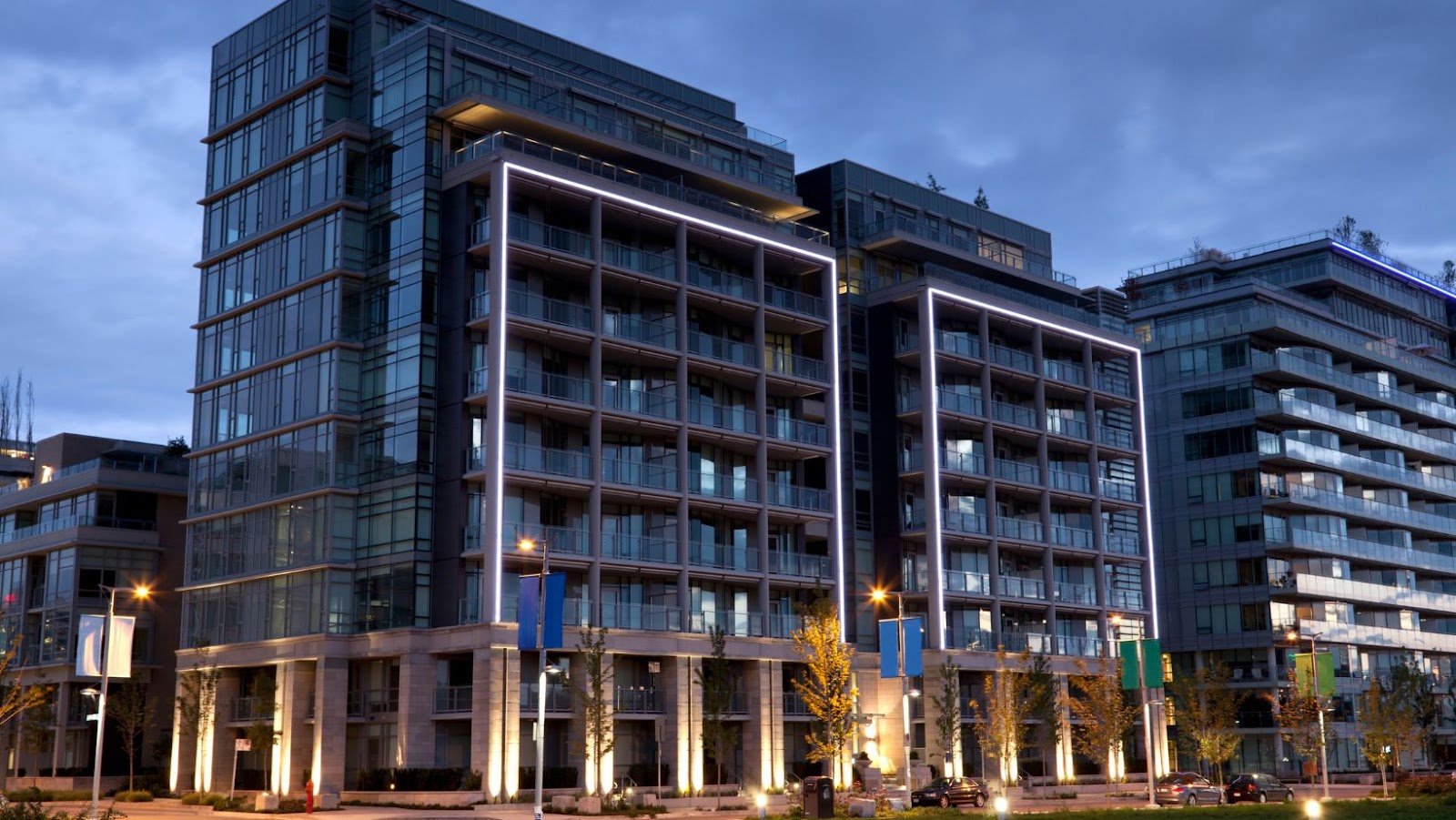Purchasing a condominium is a great way to get a piece of the real estate market without the same commitment as a house. When you own a condominium, you own the space within your unit, but you also have a share in the ownership of the common areas within the condominium. But who actually owns the common areas in a condominium? Let’s take a look.
What is a Condominium
A condominium (also known as a “condo“) is a form of ownership of real estate, where the individual units are owned and common areas are shared as a community. When new buyers purchase a unit in a condo, they have an automatic right to every shared space within the property. Common areas can range from outdoor amenities such as pools and outdoor seating, to interior needs such as maintenance of lobbies and hallways.
Typically, each individual unit within the condominium structure is privately owned by the residents who purchased the unit. The owners will pay fees and assessments for maintaining their respective units, but when it comes to collective upkeep of common areas, it’s important to know who owns them. Generally speaking all residents collectively own these shared spaces, so any decisions about upkeep or improvements must also be made collectively by all owners through their Condo Association (or Board of Directors).
The Condo Association is responsible for making collective decisions such as:
- Creating rules that govern everyone’s use of common facilities like parking lots or pools.
- Discussing rules related to noise levels or pet policies that should be respected by all members while they are in one another’s shared spaces.
- Handling matters concerning high-level repairs or renovations needed in order to keep properties up-to-date and structurally sound.
Who Owns the Common Areas in a Condominium
If you are considering the purchase of a condominium unit, it is important to know who owns the common areas in a condominium. Generally, these common areas include all of the areas that are owned jointly by each condominium unit owner and include hallways, lobbies, elevators, parking garages and even recreational facilities owned by the homeowners association.
The designation of these shared ownership common areas remains with the homeowners association until all unit owners have taken ownership. The homeowners association is typically responsible for maintaining and ensuring that all common areas remain in good condition. Depending on the location and governing regulations they could also be responsible for providing safety & security services, managing the resident regulations compliant within that particular development or community as defined by local laws. Moreover, they would likely be held accountable for dispute resolution amongst condo owners as well as overseeing any exterior changes or maintenance done on a unit within their jurisdiction.
As head of an individual condo facility’s governing body it will generally be up to the homeowners association to coordinate with any other external entities involved such as professional contractors performing maintenance/improvement projects inside or outside a single condominium unit. In some cases where an agreement exists between multiple entities (e.g.: landscapers, security companies etc.) it can be beneficial for the homeowners association to collaborate with them in order to ensure quality results.
Responsibilities of Owning a Condominium
When you purchase a condominium, you become responsible for many things that you may not think about when selecting a home. One of the main responsibilities is understanding who owns the common areas in a condominium. That could include the parking lot, courtyard, walkways, swimming pools and other shared facilities. Knowing who owns the common areas is essential for understanding the responsibilities of owning a condominium.
Maintaining the Common Areas
One of the primary responsibilities of owning a condominium is caring for the common areas that are shared by all of the owners. The exact responsibilities associated with each area typically depend on the governing documents of the condominium, your condo association and/or specific agreement between owners. In many cases, owners have collective responsibility for taking care of common areas, though specific tasks may be delegated to appointed individuals.
While individual owners have primary responsibility for taking care of their own units, they are also responsible for certain tasks associated with maintaining and caring for the condo’s shared areas. The exact list of what an owner is responsible changes depending upon where they reside and who owns these areas. Generally speaking, however, this can include tasks such as:
- Keeping landscaping in a neat and professional manner.
- Ensuring pathways and sidewalks are kept clean.
- Ensuring outdoor surfaces (such as driveways) are clear from debris.
- Cleaning up litter around common areas.
- Regularly checking communal spaces (such as swimming pools or gyms).
- Reporting any maintenance issues to management.
- Replacing light bulbs in communal lighting fixtures.
- Performing regular inspections.
- Following rules regarding use of shared areas.
- Paying assessments to fund general upkeep and repairs within the complex.
- Repainting or staining fences or walls when needed.
- Generally ensuring all exterior surfaces are maintained in good condition.
When in doubt about who owns a specific area or is responsible for certain tasks, it’s important to consult your governing documents to determine who has what type of responsibility.
Paying for Common Area Expenses
Owners in a condominium unit are responsible for the expenses related to their particular unit, and in addition may be responsible for paying a portion of their condominium association’s budget for the shared costs associated with the common areas. Common area expenses include maintenance, security, and upkeep of all common areas such as lobbies, walkways, pools and other recreational areas.
The division of payment duties is determined by two things: the state or country law governing individual condominium associations; and clause seven of your governing documents (also called the Master Deed), which typically outlines details regarding ownership funding determinations.
Common area expense payments are typically handled in one of two ways:
- Owners pay individually according to their percentage of ownership – often referred to as unit factor or percentage interest; or
- A uniform percentage payment across all units in the condo. This is determined by vote from the condo owners and documented in the association’s Bylaws, which is usually attached as an amendment to (or part of) your Master Deed.
It’s important that you stay informed about your association’s budget so that you can stay current on your payments – non-payment can result in fines or even legal action taken against you.
Resolving Disputes
Owning a condominium comes with responsibilities towards the shared common areas. The common areas in a condominium community mean all elevators, hallways, recreation areas, laundry rooms and any facility used by the owners and guests living in the building. In addition to these responsibilities, management of common areas includes reconciling disputes between owners overuse or misuse of these facilities.
In order to resolve conflicts over the use of common areas, individuals should attempt to come to their own agreement before involving their condo board and/or management company. When an agreement is not possible, owners can present their dispute to the board for resolution using established procedures that are outlined in their association’s governing documents.
Once presented with a dispute from an owner regarding use of a common area, it is important for boards to enforce the provisions of an association’s governing documents which outlines how various types of issues should be addressed by all parties involved in the conflict. This typically requires open lines of communication among residents as well as providing available resources where needed to help individual owners understand and comply with any pertinent regulations or restrictions concerning use or misuse of common property within a particular development or community.
Rules and Regulations
When you own a condominium, it is important to understand the rules and regulations that come with the associated responsibilities. You will be responsible for understanding the bylaws and rules of the condo association, as well as who owns the common areas in a condominium. It is essential to understand your rights and responsibilities as a condo owner before signing a contract.
This heading will discuss the rules and regulations surrounding condominium ownership:
Condominium Bylaws
When purchasing a condominium, prospective owners should become thoroughly familiar with the governing condominium bylaws as they provide clear information on who owns the common areas, who is responsible for their upkeep, and how the common area is to be maintained. Common areas are all areas owned collectively by the unit owners. These generally include hallways, elevators, stairs, and outdoor landscaping, as well as other shared services such as security systems and pools.
The condominium bylaws can outline different rules for different types of common property. Rules can vary depending on the type of condominium – high-rises are more likely to have more regulations than a townhouse style complex – but generally speaking all condominiums should have documented answers to questions such as:
- Who owns the common area?
- Who is responsible for its upkeep?
- How often do doors need to be replaced/repaired?
- Are pets allowed in any of these spaces?
- Are there any special rules and regulations for this area that must be abided?
Furthermore, it’s important that existing and prospective homeowners of a condominium understand how maintenance costs will be assessed in relation to ownership of common areas. Will each unit get an individual assessment or will all owners share in these costs regardless of whether they use them or not? This type of information will ensure that everyone knows their responsibilities when it comes to maintenance costs associated with common areas.
Restrictions on Use of Common Areas
When buying a condominium, owners should carefully read the documents that are included in the sale. These provide detailed information about restrictions and requirements placed on owners by local or state governments, as well as guidelines set out by the condominium association.
In general, all common areas must be used for their intended purposes only, and the use of areas that are not designated for specific purposes is prohibited. In addition, property owners may have limited access to certain common areas depending on their participation in a condominium board or an approved user group. Common areas generally include hallways, elevators, stairways, lobbies and other shared facilities such as laundry rooms or fitness centers/gyms if available.
Every owner has a responsibility to ensure that these common areas are properly maintained and kept clean for the safety and convenience of all users. All decorative items such as artwork or statues may only be displayed with written permission from the condominium association before installation or display (and they can only remain installed while they are under warranty).
The unauthorized use of any common area carries a range of penalties which may include fines or other sanctions determined by your respective board of directors. It is also important to keep in mind that unauthorized uses may not only damage property but may also prevent others from enjoying those facilities. Remember that these provisions exist in order to assure safety and promote the best interests of all residents – observe these rules accordingly for everyone’s benefit!
Financing and Insurance
When you purchase a condominium, you typically become an owner of both the unit you’ve bought and a portion of the common areas. Those common areas include the grounds, any shared amenities and the building structure itself, which are the responsibility of all the owners in that condominium community to finance and insure.
Let’s explore the financial and insurance differences between owning a condominium and a traditionally built single-family home:
Financing a Condominium
Financing a condominium can be similar to other forms of real estate financing. Most tax and deed guidelines for residential single-family homes still apply, however there are some considerations specific to condominiums that are important to familiarize yourself with before you buy.
Generally speaking, lenders will require 15-20% down for a condominium purchase in order to guard against buyers defaulting on their loans. If the building does not meet certain requirements, such as having more than 6 units or being at least three years old, then the down payment could increase up to 25%. The condo association must have all the appropriate insurance coverages in place and provide the lender with proof of that insurance coverage. Additionally, the lender may require Condominium Association bylaws as part of their review and approval process.
The scope of common area amenities will also be looked at closely and should be clearly defined in the Condo Declaration “house rules” which may suggest topics such who owns the common areas (the unit owners versus association), rules and regulations on renting out units, what constitutes a violation of homeowner rules (i.e., noise control), etc. It is important that each prospective buyer understands all fees associated with ownership as well as getting homeowner’s insurance coverage before purchasing a condo unit.
Insurance Requirements
Insurance is available for condominium owners to cover the full replacement cost of their unit, as well as personal liability and common area losses. Property insurance is important to ensure that your belongings are protected from damage or theft, whether you occupy the unit yourself or rent it out. It is also advisable for the condominium corporation (who owns the common areas in a condominium) to purchase property insurance as a group – either through one company or several companies specializing in insuring condominiums – in order to protect its investments and assets from damage due to fire, storms and other hazards.
Homeowners are responsible for purchasing individual tenant/condo unit policies, whereas the corporation must hold a “blanket” policy. Buyers need to be aware that lenders usually require that they carry enough coverage on their condo units equal at least the amount they owe on their mortgage loan plus any assessment fees that may have been imposed by the condo association. Additionally, most lenders require all policyholders to obtain liability coverage as a part of their policies. Therefore, when shopping around and comparison-shopping for insurance, make sure you have met all requirements laid out by your lender before making a final decision.
Conclusion
Owning a condominium entails a number of responsibilities, such as taking care of the unit itself, paying monthly dues, and abiding by the rules set by the local government and association. Additionally, condominium owners must also understand that their ownership extends to common areas within their development, such as entrances, pool areas, community rooms and other communal spaces that may be shared with other tenants.
Owners should be aware of their responsibilities and liabilities when it comes to these common areas and become familiar with local laws pertaining to them. With this understanding and knowledge, condominium owners can enjoy the many benefits that come with condo ownership without having any surprises down the road.







